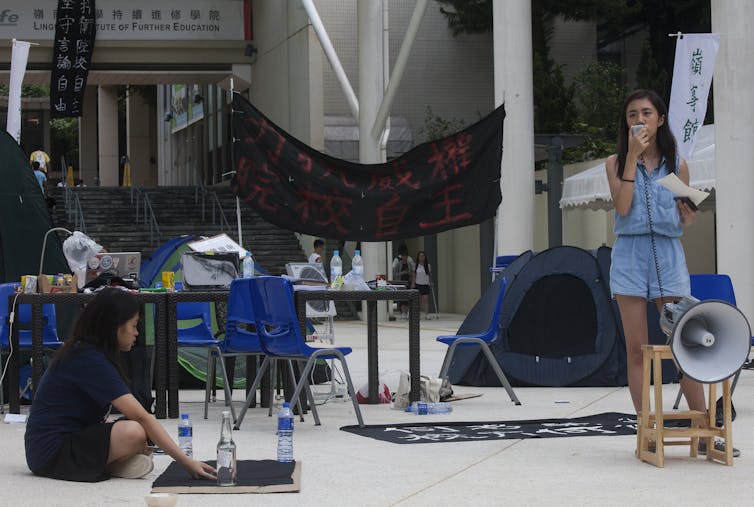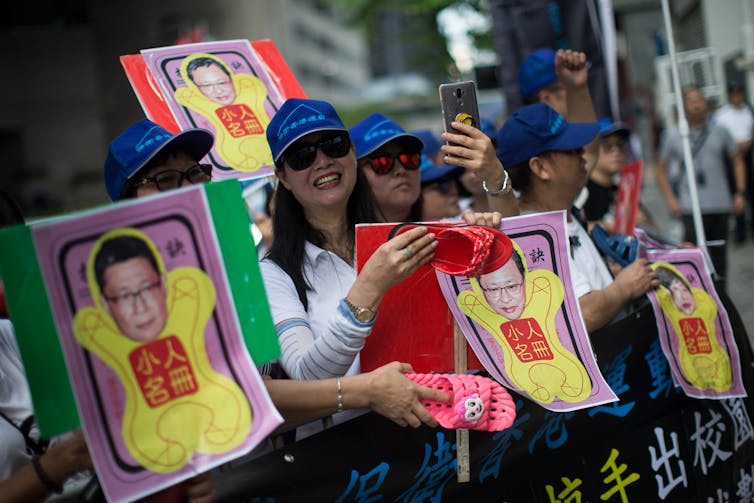Young Hong Kong democracy activists Joshua Wong, Alex Chow and Nathan Law were released on bail from jail on October 23. They will now appeal against the prison sentence for their role in the 2014 Umbrella Movement.
Hong Kong’s version of “Occupy Wall street”, the Umbrella movement against Beijing politics was the most important protest in recent years, lasting three months.
But three years later, Hong Kong’s democracy is still kept at bay.
As hundreds paid homage to the 2014 protests on September 29 in Hong Kong, the challenges facing the new generation of activists are not how to mobilise mass protests, but how to wrestle with the state’s innovative strategy to manage society.
On 17 August 2017, three leading activists, aged 19 to 24, who had served their community service sentences for civil disobedience, were imprisoned following the Hong Kong government’s unprecedented appeal of the ruling. Less than a month ago, four pro-democracy legislators, who were elected to office with more than 100,000 votes, were unseated by the Court of Appeal for their “insincere” oath taking.
Seeding discord
Citizens continue to take to the streets to voice their discontent, and strike without support from their union leaders. But the scale of their rallies has diminished, and their targets have blurred.
Hong Kong’s liberal autocracy seems to have distanced itself from contention between state and society, while benefiting from conflicts between various groups of people. Some supporting the pro-democratic movements, some forming counter-movements.
Counter-movements have also become increasingly common. Led by pro-regime groups but appearing to be citizen-based initiatives, the participants can adopt more confrontational tactics than the government and politicians. They protest side by side in peaceful rallies, enter university campuses, and bully activists on social media. These tactics have discouraged citizens from participating in mass protests by intimidation.
Young people are either alienated from politics or favour radical actions, as seen in the so-called Fishball Revolution in 2016. This is when people took part in violent protests to defend local night food stalls and businesses.
According to the sociologist Charles Tilly, states are known to respond to protests by choosing from the classic repertoire of repression, concession, or toleration.
But the response in Hong Kong suggests regimes are not adhering to the classic responses; they’re also using case-to-case and adaptive tactics to wear out challenges.
Nuanced strategy
Semi-democracies like Hong Kong cannot deploy their repressive apparatuses as readily as autocracies, for they must pay lip service to their “liberal” images. They also lack the representative mechanisms found in democracies, like full-fledged elections, for absorbing protests. Conceding to dissent is seldom an option when the demands are about political change.

A Lingnan University protest against comment made about ‘killing’ pro-Hong Kong independence advocates, Hong Kong, China, October 4.
EPA-EFE/ALEX HOFFORD
During the Umbrella Movement, the state attempted to repress the nascent protest through tear gas, but it backfired when hundreds of thousands of citizens occupied several city centres. The massive mobilisation, which went beyond anyone’s imagination, forced the state to retreat.
So they had to come up with more a nuanced strategy to quell dissent.
The state turned to a smarter strategy, what we call “attrition,” for wearing out the resilient occupation.
Attrition entails an array of defensive and offensive tactics that go beyond simply tolerating or ignoring protests.
These include a progressive effort to maintain cohesion among political elites, such as organising summits for elites to openly declare loyalty, or punishing elites who express sympathy for the dissent. Through this effort, the state sent a powerful message to incumbents considering defection.
Pro-regime movements
The state also relies on pro-China counter-movements to curb pro-democracy activism.
For instance, during the Umbrella Movement, counter-movement groups such as the Voice of Loving Hong Kong and the Silent Majority for Hong Kong would attack and provoke protesters in the occupied sites. These groups exerted a clear impact on the Umbrella protesters: not only did these “disturbances” constrain the actions of protest leaders, they also created a violent image in the protest sites.
Such counter-protests were likely mobilised or incentivised through money or position. But no clear evidence has yet pointed to the role of the state in orchestrating them.
Three years after the 2014 Umbrella Movement, such counter-movements continue to thrive. Some have become proactive in attacking public figures whom they identify as “enemies of the state,” such as by labelling them as stooges of foreign powers on social media or through mass rallies.
Even pop singers who had voiced support for the Umbrella protests, like Denise Ho and Anthony Wong, were not spared from this kind of cultural-revolution-like assault.

Pro-China activists with the ‘Defend Hong Kong Campaign’ protest outside the District Court in Hong Kong, China, 19 September 2017.
EPA-EFE/JEROME FAVRE
Legal intervention
The most effective part of this new strategy was legal intervention.
As a highly revered institution in Hong Kong, the legal system gave the government the legitimacy it lacked to scale back the protests. It became a third-party actor and shifted the burden of evicting the protest from the police to the judiciary.
Court injunctions filed by private actors, such as transport companies, helped re-frame the protests from political contention to court disputes and added a touch of unlawfulness to the protests.
Like counter-movements, the judiciary has continued to be featured in political disputes. The disqualification of popularly elected legislators and the jailing of young activists, such as Umbrella Movement leaders Joshua Wong, Nathan Law and Alex Chow, were pertinent examples.
What we are now observing in Hong Kong is an evolving semi-authoritarianism. The attrition strategy that it used for quelling the Umbrella Movement since 2014 has been extended into some sort of “soft repression” of the pro-democracy movement.
Relying on third party actors such as pro-China movements to crush the actions and hopes of pro-democracy activists, the government avoids direct confrontation and preserves its façade of an impartial arbiter amid growing social polarisation.
Despite featuring the rule of law and civil liberties, Hong Kong’s trajectory steadily echoes the democratic recession worldwide.
>>> Read full article>>>
Copyright for syndicated content belongs to the linked Source : The Conversation – https://theconversation.com/how-hong-kong-umbrella-movement-was-crushed-and-pro-democracy-activists-gradually-silenced-84339































